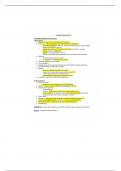Postpartum Nursing Care
Immediate Postpartum Nursing care
Vagina delivery
● Stay in L&D room for 1-2 hours depends on recovery
● Vital Signs - V/S checked every 4 hours for first 24 hours postpartum
- Orthostatic hypotension: after birth, resistance of BF drops when sitting/standing.
Always need assistant to get up
- Temperature may rise to 100.4 the first 24 hours (if over 24 hr= concern)
- Normal postpartum bradycardia
- Edema in lower extremities is common
- Assess for thrombosis each assessment (look for red tender vein or edema)
● Bleeding
- Fundal massage (always 1st action)
- Give pitocin IV or IM to help uterus contract
● Perineum: ice to perineum if needed
● Pain medications
● Breastfeeding- good to get started the first hour of birth before the baby gets sleepy,
promotes bonding, and help uterus contract
● Bladder
- Observe for bladder distention and urination
- Assess for burning or pain during urination, signs of UTI
- Urine is observe for blood to indicate trauma
- Record outtake, at least until mom urinates 150 mL
● Ambulation: watch for BP drop first time getting up
C-section delivery
● PACU for 2 hours
- depends on return of sensation from spinal epidural
● Vital signs every 15 mins and ECG (electrocardiogram) /O2 sats
● Bleeding and surgical site
- Fundal massage
- Pitocin IV: more pitocin IV after C-section than vaginal delivery
- Ice to surgical site: to decrease edema, also to the perineal area (if they were
pushing previously then went to emergency c-section)
● SCD’s/ Foley
● Medication- itching around the mouth and nose after spinal post-delivery is not
considered an allergic reaction to Morphine. Nubain is used for itch relief
● Assess dermatomes - assess for sharp and dull feeling sensations
● Breastfeeding
BUBBLE-E (breasts, uterus, bladder, bowel, lochia, emotional status, episiotomy/ extremities)
Breasts -( maternal physical changes )
, ● Oxytocin release stimulates prolactin and production of milk and let-down
- Milk is released by contractions of alveoli of breasts
● Colostrum is the 1st milk secretes and is rich in protein and immunoglobulins
- For the first 2 or 3 days there’s colostrum, the breasts are soft but not totally full.
By the third day it will start to be full/firm for translucent milk.
- Colostrum milk is rich in protein and has laxative properties for baby to poop
(helps to excrete the bilirubin in the system, want bby pooping)
● Primary engorgement occurs on 2-3rd day as transitional milk is produced
- Breast engorgement occurs, it’s hard, erect, full and very uncomfortable. Due to
increase blood flow for transitional milk
Breast assessment
● For assessment check for women’s breast for consistency, size, shape, and symmetry
● Palpate for engorgement or tenderness
● Inspect nipples for redness, cracks, soreness, and erectility if nursing
- Flat or inverted nipples make difficult for baby to latch
● Is mother breast or bottle feeding?
- If bottle feeding, mom should avoid stimulating her nipples ex) face away from
water spraying in shower
- When breastfeeding, place the nipple in baby’s comfort zone palet (soft palate in
the back of mouth)
Uterus
● Involution - refers to changes that the reproductive organ, the uterus, undergo after birth
to return to prepregnancy size and condition. (uterus returning to natural non pregnant
state)
- The uterus undergoes rapid reduction in size and weight after birth. Should return
by 5-6 wks
- Factors that enhance involution is breast feeding, fundal massage, contractions
- Factors that slow involution: full bladder, amount of distention uterus, long difficult
labor, anesthesia, # of babies they had (uterus is tired), infection, retained
placenta (fragments still inside)
● Subinvolution - failure of uterus to return to non pregnant state after 6 weeks
● Contractions- also called afterpains, often are more painful for multiparous women and
with breastfeeding bc release of oxytocin
Uterus assessment
● Palpate the fundus
- Identify need for fungal massage. When uterus is soft and high, need it. When it’s
firm, don’t need
● Assess firmness, height of fundus, and position in relation to midline of the abdomen
● Correlate fundal location with descend of 1 cm each day of postpartum
ex) day 1 postpartum will be above umbilicus




